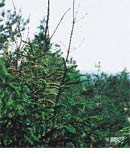 |
>
> Passive
Monitoring
>
|
|
Passive Monitoring
Passive monitoring can be a rather active process, because air pollutant effects are assessed in plants and other organisms in the field where they grow. Besides expert vision and perception, outdoor skills may be necessary. Frequently used methods of passive monitoring are, besides others:
|
 |
|
|
|
|
 Standardised Mapping of Lichens for the assessment of air quality (VDI-Guideline 3799 /1) Standardised Mapping of Lichens for the assessment of air quality (VDI-Guideline 3799 /1)
Mainly acidic air pollutants, but also heavy metals, are the majors causes for the decline or complete loss of sensitive lichen species. The composition of lichen vegetation can be monitored in dense networks at moderate expense. Air quality indices are calculated, based on the information of frequency and specific susceptibility of the lichen species, and can be depicted in illustrative maps.
This method provides an impressive illustration of how abatement of emissions can result in positive effects, shown as lichen communities are re-established over time.
Lichens respond to air pollution stress as their vitality is visibly reduced and they decline, - partially or fully - or ultimative disappear completely. Lichens are therefore called sensitive bioindicators.
|
|

Many Lichen species respond very sensitively to the impact of air pollution |
 |

In spruce needles, pollutants can accumulate over several years.
|
|
 Spruce needle monitoring
Spruce needle monitoring
Needles are sampled from selected spruce trees on the site according to detailed sampling schemes and instructions.
The pollutants, accumulated in the waxy surface of the needles (cuticle), are identified and quantified in the laboratory, e.g. metals as well as semivolatile organic pollutants, like polycyclic aromatic hydrocarbons (PAHs), polychlorinated biphenyls (PCBs) or polychlorinated dioxins and furans (PCDD, PCDF).
|
 |
 Moss monitoring to assess deposition and accumulation of air pollutants
Moss monitoring to assess deposition and accumulation of air pollutants
With the moss monitoring, samples of mosses are collected on the site and are analysed in the laboratory for their content of pollutants, e.g. (heavy) metals. Since the uptake from the soil is negligible, the contents of pollutants in the mosses closely reflect the pollutant level deposited from the air onto the site.
Large-scale surveys of heavy metal deposition in dense networks, comprising several 1000 sites, have been repeatedly undertaken all over Europe. Results are presented in informative and illustrative maps. Changes over time, i.e. several years or even decades, are also demonstrated.
This method can also be applied successfully in small-scale monitoring, e.g. around single emission sources or for the identification of pollution sources.
Since the contents of pollutants accumulated in the plants tissue is determined, mosses are used as accumulation bioindicators.
|
|